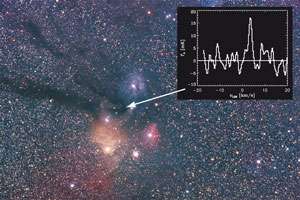Elusive oxygen molecule finally discovered in interstellar space

Molecular oxygen has finally been discovered in interstellar space. The result is important for understanding the chemistry in large interstellar clouds where new stars are formed, and the processes behind star formation.
Researchers using the Odin space observatory have spent many hours of observations during several years and painstaking data evaluation in search for molecular oxygen. Previous attempts to find the elusive molecule made by observatories both on ground and in space were unsuccessful, and it was then realized that the abundance of oxygen was much lower than assumed before the search started. Just how low has not been known until the Odin measurements. The discovery is published in Astronomy & Astrophysics.
Astrochemists have long argued that the Life molecules, water (H2O) and oxygen (O2), are highly abundant in the denser regions of the interstellar medium. One of the primary goals of the Odin astronomy mission was to use spectral line data from molecular oxygen (O2) and water H2O) to study processes of star formation. Models at the time predicted that these molecules would be abundant enough to assist the formation of stars by radiating away excess energy produced when clouds collapse to form new stars. The cloud collapse results in compression of the gas which is therefore heated.
Unless this excess heat can be radiated away stars will not be able to form. Many attempts have been made from the ground, balloons and space to detect O2 but have, until now, all failed. Molecular oxygen has now finally, for the first time, been detected by a group of scientists from Sweden, Canada, Finland and France. The molecule was found in a dense (astronomically speaking) gas cloud (called rho Oph A) in the constellation of Ophiuchus at a distance of about 500 light years. The O2 abundance is a thousand times lower than can be explained by today's chemical models. This discovery is important as it will lead to new insight into the complex development of interstellar clouds forming stars and planets.
Odin is a space-based radio observatory for studying both celestial objects and the Earth's atmosphere. The spacecraft is equipped with a 1.1-metre diameter radio telescope operating in the millimetre and submillimetre wavelength ranges. Odin was launched into a 600 km altitude orbit on 20 February 2001.
The importance of molecular oxygen led to the inclusion in the Odin five-channel microwave radiometer of a dedicated radio receiver tuned to the ground state transition of O2 at 118.75 GHz. (This frequency is about a factor 1000 higher than the typical FM radio band). Following intense technical development, at the Swedish Chalmers University, Jet Propulsion Laboratory, and TRW, the Finnish Ylinen-built receiver could be equipped with a three-stage transistor-based pre-amplifier. Due to the very high frequencies, new materials such as InP substrates and methods to build Monolithic Microwave Integrated Circuits (MMIC) had to be developed. In order to reduce the noise, amplifiers and mixers are cooled by a Stirling cooler to about –140˚ C.
The actual observations were made during 33 days over a period from August 2002 to February 2006. After careful processing and detailed analysis of more than 300 000 spectra, the O2 line is convincingly visible, at a level of five times above the noise. The characteristics of the observed O2 profile are precisely as expected, based on the profiles of the spectral lines from other species like atomic carbon, carbon monoxide and water vapour, observed from the same cloud with ground-based telescopes and with Odin.
Odin was developed by the Swedish Space Corporation, which is also responsible for the operations, on behalf of the Swedish National Space Board and the space agencies of Canada, Finland and France. It serves astronomers and aeronomers of all four partner countries.
Source: Swedish Space Corporation





















